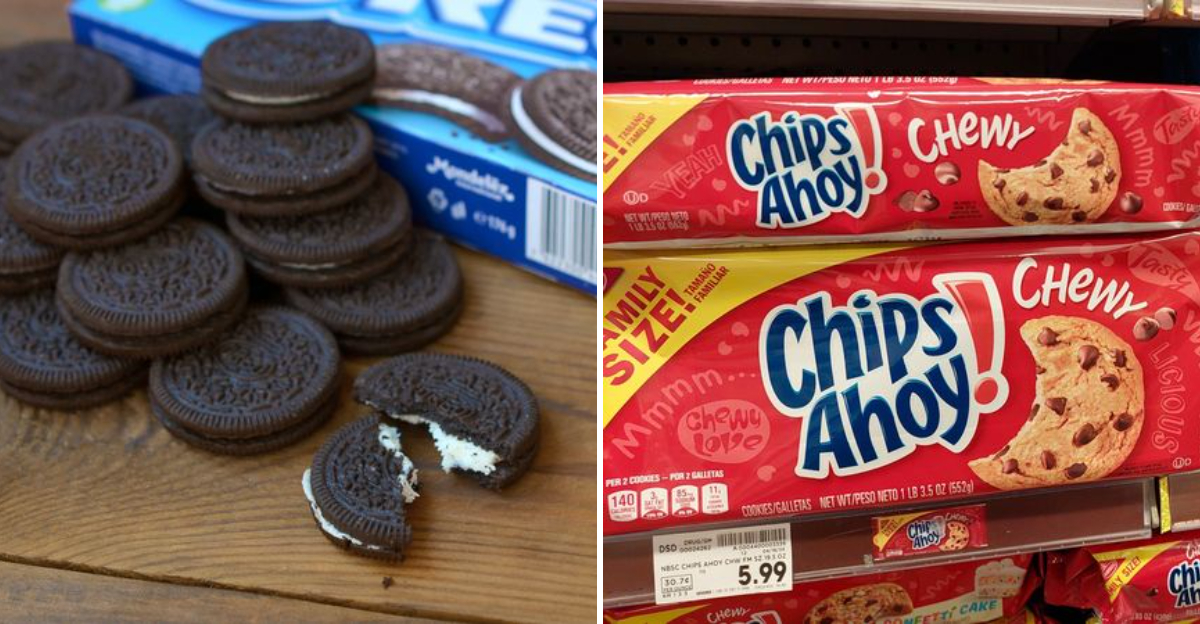7 Store-Bought Cookies Made With Ingredients To Avoid

I’ve always been a cookie monster at heart, but my recent deep dive into ingredient labels left me feeling betrayed by my favorite treats.
Those innocent-looking packages hiding on supermarket shelves aren’t always as sweet as they seem.
Many popular store-bought cookies contain ingredients that nutritionists warn against – from artificial colors linked to hyperactivity to preservatives with questionable health effects.
Let me walk you through seven common cookies that might make you think twice before your next snack attack.
1. Nabisco Chips Ahoy! Chewy Cookies: High Fructose Horror Show
Last weekend, I grabbed my trusty bag of Chips Ahoy! Chewy cookies for a movie night, only to choke on my milk when I finally read the ingredient list. These soft chocolate chip delights harbor high fructose corn syrup – a laboratory-created sweetener that’s been linked to obesity and metabolic disorders.
The plot thickens with partially hydrogenated oils lurking in older formulations, though they’re being phased out. These trans fat culprits raise your bad cholesterol while lowering the good kind – a double cardiac whammy! Don’t be fooled by their irresistible chewiness either. That texture comes courtesy of artificial flavors and numerous preservatives designed to keep these cookies shelf-stable for practically an eternity. Your taste buds might thank you momentarily, but your body will be filing complaints for hours afterward.
2. Oreo Double Stuf: The Artificial Color Catastrophe
Confession time: I once ate an entire sleeve of Double Stuf Oreos during a particularly stressful exam week. If only I’d known what was hiding in that creamy white center! These iconic sandwich cookies contain titanium dioxide – the same chemical used in paint and sunscreen – to achieve that blindingly white filling. Artificial colors like Blue 1 and Red 40 make appearances in specialty Oreo varieties.
These synthetic dyes have been banned in some European countries due to potential links with behavioral issues in children. The ingredient list also flaunts high fructose corn syrup and palm oil – environmental concerns aside, this oil is high in saturated fat. My childhood favorite suddenly seems less innocent when you realize it’s essentially processed sugar and fat held together with questionable chemicals.
3. Chips Ahoy! Original: Preservative Paradise
Remember when I discovered my grandmother’s forgotten Chips Ahoy! package that somehow remained mysteriously “fresh” after months in her pantry? That supernatural shelf life comes from TBHQ (tertiary butylhydroquinone) – a petroleum-derived preservative that prevents rancidity but has been linked to vision disturbances and childhood behavioral issues in some studies. The original Chips Ahoy! also contains artificial flavors alongside natural ones.
This sneaky labeling trick means manufacturers don’t have to disclose exactly what chemicals create that “homemade” taste illusion. Soybean oil, another common ingredient, often comes from genetically modified crops unless specified otherwise. While the FDA considers these ingredients safe in limited quantities, the cumulative effect of consuming multiple processed foods containing these additives daily raises eyebrows among health researchers.
4. Reese’s Peanut Butter Cup Cookies: Emulsifier Extravaganza
My peanut butter addiction led me straight to these tempting treats last month. What a sugar rush! But that distinctive mouthfeel? It comes courtesy of PGPR (polyglycerol polyricinoleate) and other emulsifiers that create texture while extending shelf life – ingredients that have been linked to gut microbiome disruption in preliminary studies.
The peanut butter filling contains more sugar than actual peanuts, plus fully hydrogenated vegetable oils. These processed oils undergo extensive chemical modification to achieve stability, resulting in a product far removed from anything found in nature. Vanillin, the artificial vanilla flavor used instead of real vanilla, is typically synthesized from wood pulp or petroleum byproducts. While safe according to regulators, it exemplifies how processed foods substitute lab-created compounds for simple ingredients your great-grandparents would recognize.
5. Store-Brand Vanilla Sandwich Cookies: Titanium Dioxide Troubles
Grocery shopping on a budget last year led me down the generic cookie aisle, where I discovered store-brand vanilla sandwich cookies at half the price of Oreos. Bargain score! Or so I thought until investigating further. Many store-brand cookies contain higher levels of titanium dioxide than name brands. This whitening agent, recently banned in food by the European Union, has been linked to inflammatory bowel diseases and potential DNA damage in preliminary studies.
Artificial vanilla flavoring in these budget options often contains propylene glycol – a compound also used in antifreeze. While the food-grade version is deemed safe in small quantities, it exemplifies how manufacturers prioritize cost-cutting over ingredient quality. The savings might seem sweet initially, but the long-term health costs make these bargains questionable at best.
6. Little Debbie Oatmeal Creme Pies: Corn Syrup Central
Those Little Debbie Oatmeal Creme Pies in my lunchbox were the envy of my elementary school cafeteria. Now they’re exhibits in my personal food crime investigation! The first ingredient after flour? Corn syrup, followed closely by high fructose corn syrup – double trouble for your blood sugar. The creamy filling achieves its cloud-like texture through partially hydrogenated oils and artificial flavors. That nostalgic taste comes from laboratory-created compounds rather than genuine ingredients.
Color me shocked when I discovered these also contain sodium stearoyl lactylate and other dough conditioners that sound more appropriate in a chemistry textbook than a cookie. While these additives improve texture and extend freshness, they represent how processed modern cookies have become – engineered food products designed for profit margins and shelf stability rather than nutritional value.
7. Crumbl Pink Sugar Cookie: Artificial Color Conundrum
My Instagram feed practically forced me to try the famous Crumbl Pink Sugar Cookies last year. They’re gorgeous, I’ll give them that! But that perfect pink hue? It comes from Red 40 – a synthetic dye derived from petroleum that’s been linked to hyperactivity in children and is banned in several European countries. Beyond the concerning coloring, these social media darlings contain artificial flavors and palm oil – an ingredient associated with deforestation.
The almond extract that gives these cookies their distinctive flavor is often synthetic rather than derived from actual almonds. Sugar appears multiple times in different forms throughout the ingredient list – a manufacturer trick to avoid listing it as the first ingredient. When combined with refined flour and minimal fiber, these cookies create the perfect blood sugar rollercoaster. They may be picture-perfect for your social feed, but they’re anything but perfect for your body.
